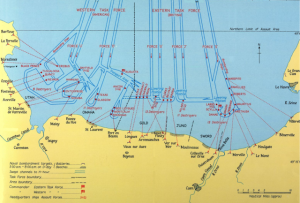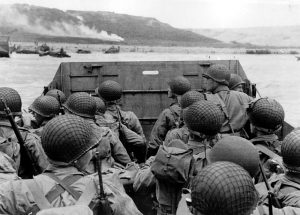By Steve Johnson
After bouncing all night in cold, cramped steel boats, then waiting all day in broiling heat, the men of the Allied Expeditionary Force got the word: shortly after sundown, they would finally be getting off their floating, seasick prisons.
All they had to do then was run straight into machine gun fire, smash the Nazi army, and liberate Europe.
On June 6, 1944, about 100,000 American, British, and Canadian soldiers climbed out of the water at high tide and landed in German-occupied France. Hundreds were cut down before they even touched the sand; thousands more were hit crossing the beach. Nearly everyone, especially the Americans, landed in the wrong place, far from their commanders, their support, and their buddies. But the ones who weren't killed, and even some who were wounded, pressed on into the teeth of murderous fire from defenses the Germans had been building for four entire years.
Two British divisions landed on the left flank, near the ancient city of Caen. A Canadian division landed on a beach code-named Juno. Utah was at a right angle to Omaha, part of the Cotentin Peninsula that sticks up from France like a jauntily upraised thumb. Omaha was right in the corner, where a river provided an excellent, and obvious, route inland.

Of course, the Germans knew all about it.
They had used up most of Europe's concrete building forts right along the water's edge. Their commander, the legendary Erwin Rommel, believed that if he didn't push the Allies back into the sea on the first few days of the invasion, he would never get them out of France. Hitler wasn't so sure and had left orders that the German Panzer (tank) divisions were not to be moved without Hitler's direct approval.
When Rommel heard about the invasion, he was in Germany in response to a summons from Hitler. He hadn't made it to Berlin yet, and when he got the news, he headed back to the front. Hardly anyone even knew he'd been in Germany, but because of this errand, he was away from the battlefield on that crucial first day.
Hitler, meanwhile, had been up hours past midnight the night before, as he so often did in those days. He slept late, and no one wanted to wake him, fearful of his increasingly violent rages. So for most of D-Day, the German tanks sat, waiting, for orders that never came. And back on the beaches, the German infantry killed Allies until they were shot, grenaded, and bayonetted out of their bunkers.
The British had most of the tanks on D-Day; a new American tank designed to float into shore like a motorboat hadn't worked out. Most of them sank. But right behind the British beaches were the suburbs of Caen, a dense Norman city of sturdy stone houses that might have been deliberately designed to frustrate tankmen. Field Marshal Montgomery, the overall commander of D-Day, had hoped to take Caen by nightfall on the first day, but his forces took more than five weeks to actually clear the town. In fact, they never really did take the city; they had to back up and flatten Caen with heavy bombers, until nothing was left but a jagged field of rubble, before the Germans would give up.
The Americans didn't have much armor, but they had the veteran 1st and 4th Infantry Divisions. The 1st, known as the Big Red One, had been in every major seaborne invasion of the entire European war, so they were better at this difficult job than anyone else but the Marines.
Also in the first wave was the 29th Infantry Division, a National Guard unit from Virginia and Maryland. The 29th had never seen combat, but they had been training in England for over a year for this one mission. Their division yell was "Twenty-Nine Let's Go!" When some of the 1st Division's men heard it, they yelled out, "Go on ahead, Twenty-Nine, we'll be right behind you!"
The invasion plan specified exactly which boats were to hit the beach at precise intervals: these infantry companies at 6:00, followed by engineers at 6:03, then anti-tank teams at 6:05, down the list for hours of planned landings.
But it wasn't possible to rehearse a movement of thousands of ships and planes, even over a short stretch of water like the English Channel, all at the same time. Many of the ships were manned by fresh Navy enlistees, some of whom hadn't seen salt water in their entire peacetime lives. Much of the Navy's best was in the Pacific, fighting the Japanese, or out in the Atlantic, dodging U-boats to keep a trickle of food flowing to England. The sailors had to cross thirty miles of water in darkness, so as to avoid tipping off the Germans. They found France all right, but it's not surprising that many of them were miles out of place and many minutes off schedule.
At Utah and the British-Canadian beaches, the first boats ashore managed to get a foothold for the follow-up waves. But on Omaha, boats arrived a few at a time, dumping their troops onto a booby-trapped, bullet-swept beach littered with American dead. Gradually, a sergeant here, a captain there, took charge of whoever was nearest and rushed up to the seawall, sheltering from bullets as thick as rain until they could knock out the German defenses.
Earlier that morning, just before midnight, three divisions of paratroops had jumped into France to open the way for the seaborne landings. But the pilots delivering them to their drop zones had never flown so low and fast in darkness before, and many of them got lost. Others, unnerved by anti-aircraft fire, dodged and swerved, dropping their parachutists much too fast and scattering them over dozens of miles. Some paratroopers, laden down with more than lbs. of weapons and equipment, landed in ponds, rivers or flooded fields and drowned before they could get loose of their burdens.
But the scattered drop had an unforeseen advantage. The Germans were getting reports of parachutes sighted all over Normandy; they assumed the drop was being done according to plan and that there must be upwards of 90,000 men now jumping into battle. After all, no sensible planner would drop single soldiers here and there across the countryside; they'd drop whole platoons, companies or battalions onto enemy strong points. So much German effort was wasted in those first critical hours chasing after phantom paratroopers, seeking hundreds of men where only a handful actually were.
So while the seaborne troops staggered ashore, the German reinforcements who might have pushed them back into the sea were running around inland. The paratroops, specially selected for fitness, bravery and skill, shot up the confused, third-line German troops despite the numerical odds. Instead of a narrow carpet cleared of Germans, the paratroops had created a huge zone of confused battle in which the Germans were looking the wrong way.
Omaha Beach continued to be a slaughterhouse all morning long. When he heard the first reports of casualties on the beach, General Omar Bradley considered calling off the follow-up waves and conceding Omaha to the enemy. Like most generals on the Allied side, Bradley had fought in the First World War, whose butcher's bills were higher than anything history had ever seen. Casualties were expected and acceptable; casualties that didn't produce a result, however, were not. Just as he was steeling himself to call Eisenhower and admit that the Americans couldn't take Omaha Beach, Bradley's aides spotted several men moving up the bluffs off the beach. More and more followed them. The massacre on Omaha had not been in vain, and now the way was open into the interior of Europe.
Our D-Day resource list has new and classic titles that offer military perspectives from all sides of the engagement. Most books and videos may be reserved by our customers for pick up at a favorite branch.




